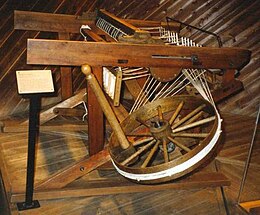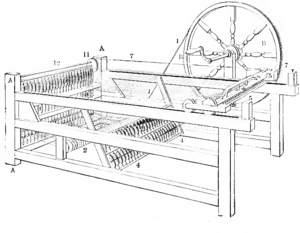Is The Spinning Jenny Still Used Today

Model of spinning jenny in the Museum of Early Industrialisation, Wuppertal, Frg
The spinning jenny is a multi-spindle spinning frame, and was one of the key developments in the industrialization of material manufacturing during the early Industrial Revolution. It was invented in 1764 or 1765 by James Hargreaves in Stanhill, Oswaldtwistle, Lancashire in England.
The device reduced the corporeality of piece of work needed to produce cloth, with a worker able to work 8 or more spools at once. This grew to 120 as applied science advanced. The yarn produced by the jenny was not very potent until Richard Arkwright invented the water-powered h2o frame. The spinning jenny helped to starting time the factory system of cotton manufacturing.[i]
History [edit]
The spinning jenny was invented by James Hargreaves. He was built-in in Oswaldtwistle, near Blackburn, effectually 1720. Blackburn was a town with a population of nigh five,000, known for the production of "Blackburn greys," cloths of linen warp and cotton weft initially imported from India. They were usually sent to London to be printed.
At the time, cotton production could not keep up with need of the fabric manufacture, and Hargreaves spent some time considering how to improve the procedure. The flight shuttle (John Kay 1733) had increased yarn demand by the weavers by doubling their productivity,[2] and now the spinning jenny could supply that demand past increasing the spinners' productivity fifty-fifty more. The machine produced coarse thread.

The improved spinning jenny that was used in cloth mills
Components [edit]
The thought was adult past Hargreaves equally a metallic frame with viii wooden spindles at i end. A set of eight rovings was attached to a beam on that frame. The rovings when extended passed through ii horizontal bars of wood that could be clasped together. These bars could be drawn along the pinnacle of the frame by the spinner'due south left hand thus extending the thread. The spinner used his right hand to rapidly turn a wheel which caused all the spindles to revolve, and the thread to be spun. When the bars were returned, the thread wound onto the spindle. A pressing wire (faller) was used to guide the threads onto the right identify on the spindle.[three]
The politics of cotton [edit]
In the 17th century, England was famous for its woollen and worsted fabric. That industry was centred in the east and due south in towns such as Norwich which jealously protected their product. Cotton wool processing was tiny: in 1701 just 1,985,868 pounds (900,775 kg) of cotton fiber-wool was imported into England, and by 1730 this had fallen to 1,545,472 pounds (701,014 kg). This was due to commercial legislation (Calico Acts) to protect the woollen industry.[4] Cheap calico prints, imported past the East Republic of india Visitor from "Hindustan", became pop. In 1700 an Act of Parliament was passed to prevent the importation of dyed or printed calicoes from India, People's republic of china or Persia. This caused grey cloth (calico that hadn't been finished - dyed or printed) to exist imported instead, and these were printed in southern England with popular patterns. Lancashire businessmen produced grayness cloth with linen warp and cotton weft, which they sent to London to be finished.[4] Cotton fiber-wool imports recovered and past 1720 were almost back to 1701 levels. Again the woollen manufacturers claimed this was taking jobs from workers in Coventry.[5] Another law was passed, to fine anyone caught wearing printed or stained calico; muslins, neckcloths and fustians were exempted. It was this exemption that the Lancashire manufacturers exploited.
The apply of coloured cotton fiber weft, with linen warp was permitted in the 1736 Manchester Act. There now was an artificial need for woven cloth. In 1764, 3,870,392 pounds (1,755,580 kg) of cotton-wool was imported.[6]
The economics of Northern England in 1750 [edit]
In England, before canals, railways, and before the turnpikes, the only way to transport goods such as calicos, broadcloth or cotton fiber-wool was by packhorse. Strings of packhorses travelled along a network of bridle paths. A merchant would be away from home well-nigh of the year, carrying his takings in cash in his saddlebag. Later on a series of chapmen would work for the merchant, taking wares to wholesalers and clients in other towns, and with them would go sample books.[7]
Earlier 1720, the handloom weaver spent part of each mean solar day visiting neighbours buying any weft they had. Carding and spinning might exist the only income for that household, or office of it. The family might farm a few acres and bill of fare, spin and weave wool and cotton fiber.[viii] It took three carders to provide the roving for one spinner, and up to three spinners to provide the yarn for one weaver. The process was continuous, and washed past both sexes, from the youngest to the oldest. The weaver would go once a week to the marketplace with his wares and offer them for auction.
A change came near 1740 when fustian masters gave out raw cotton and warps to the weavers and returned to collect the finished cloth (Putting-out system). The weaver organised the carding, spinning and weaving to the primary'south specification.[ix] The master so dyed or printed the grayness textile, and took it to shopkeepers. Ten years subsequently this had inverse and the fustian masters were centre men, who collected the grey cloth and took it to market in Manchester where it was sold to merchants who organised the finishing.
To handweave a 12-pound (5.four kg) piece of eighteenpenny weft took fourteen days and paid 36 shillings in all. Of this nine shillings was paid for spinning, and nine for carding.[8] So by 1750, a rudimentary manufacturing system feeding into a marketing system emerged.
In 1738 John Kay started to improve the loom. He improved the reed, and invented the raceboard, the shuttleboxes and the picker which together allowed 1 weaver to double his output. This invention is commonly chosen the flight shuttle. It met with violent opposition and he fled from Lancashire to Leeds.[10] Though the workers thought this was a threat to their jobs, it was adopted and the pressure was on to speed up carding and spinning.
The shortage of spinning chapters to feed the more efficient looms provided the motivation to develop more productive spinning techniques such every bit the spinning jenny, and triggered the beginning of the Industrial Revolution.
Success [edit]
Hargreaves kept the car secret for some time, but produced a number for his ain growing industry. The price of yarn fell, angering the large spinning community in Blackburn. Somewhen they bankrupt into his house and smashed his machines, forcing him to abscond to Nottingham in 1768. This was a centre for the hosiery industry, and knitted silks, cottons and wool. There he set up shop producing jennies in hugger-mugger for one Mr Shipley, with the aid of a joiner named Thomas James. He and James set upward a textile business in Manufactory Street. On 12 July 1770, he took out a patent (no. 962) on his invention, the Spinning Jenny—a machine for spinning, cartoon and twisting cotton fiber.[eleven] [12] Past this time a number of spinners in Lancashire were using copies of the machine, and Hargreaves sent find that he was taking legal action confronting them. The manufacturers met, and offered Hargreaves £three,000. He at offset demanded £vii,000, and stood out for £iv,000, merely the instance somewhen cruel apart when it was learned he had sold several in the past.[13]
The spinning jenny succeeded because it held more than ane brawl of yarn, making more yarn in a shorter time and reducing the overall cost. The spinning jenny would not accept been such a success if the flying shuttle had not been invented and installed in material factories. Its success was express in that information technology required the rovings to be prepared on a wheel, and this was express by the need to bill of fare by hand.[1] Information technology continued in mutual use in the cotton and fustian manufacture until about 1810.[14] The spinning jenny was superseded by the spinning mule. The jenny was adjusted for the process of slubbing, being the ground of the Slubbing Billy.[15]
Origin and myth [edit]
The nigh common story told about the invention of the device and the origin of the jenny in the machine's name is that a daughter (or his wife) named Jenny knocked over i of their own spinning wheels. The device kept working every bit normal, with the spindle now pointed upright. Hargreaves realized there was no detail reason the spindles had to exist horizontal, as they always had been, and he could place them vertically in a row.[16]
The name is variously said to derive from this tale. The Registers of Church Kirk show that Hargreaves had several daughters, merely none named Jenny (neither was his married woman). A more likely explanation of the name is that jenny was an abbreviation of engine.[17]
Thomas Highs of Leigh has claimed to be the inventor[eighteen] and the story is repeated using his married woman'due south proper noun.
Another myth has Thomas Earnshaw inventing a spinning device of a similar clarification – simply destroying information technology after fearing he might be taking bread out of the mouths of the poor.[19]
See as well [edit]
- Cotton mill
- Luddite
- Spinning mule
- Fabric industry during the Industrial Revolution
- Material manufacturing
- Timeline of wear and textiles technology
References [edit]
- ^ a b Espinasse 1874, p. 322
- ^ Timmins 1993, p. 18.
- ^ Baines 1835, p. 157
- ^ a b Espinasse 1874, p. 296
- ^ Espinasse 1874, p. 298
- ^ Espinasse 1874, p. 299
- ^ Espinasse 1874, p. 300
- ^ a b Espinasse 1874, p. 306
- ^ Espinasse 1874, p. 304
- ^ Espinasse 1874, p. 313
- ^ Espinasse 1874, p. 325
- ^ Aiken, John. "John Aitken on the industrialization in and around Manchester, 1795". Retrieved 26 Nov 2016.
- ^ Baines 1835, p. 162
- ^ Guest 1828 and could produce both weft and warp for the woollen industry.
- ^ Marsden 1884, p. 219
- ^ Bellis, Mary: «Spinning Jenny - James Hargreaves», Nearly.com
- ^ Harling, Nick. "James Hargreaves 1720-1778". Cotton Town: Blackburn with Darwen. Archived from the original on fifteen June 2010. Retrieved 17 May 2009.
- ^ Baines 1835, p. 155
- ^ Espinasse 1874, p. 316
Bibliography [edit]
- Baines, Edward (1835). History of the cotton wool manufacture in Great United kingdom;. London: H. Fisher, R. Fisher, and P. Jackson.
- Nasmith, Joseph (1895). Recent Cotton Mill Construction and Engineering science (Elibron Classics ed.). London: John Heywood. ISBN1-4021-4558-6.
- Marsden, Richard (1884). Cotton Spinning: its development, principles and practice. George Bell and Sons 1903. Retrieved 26 Apr 2009.
- Marsden, ed. (1909). Cotton Yearbook 1910. Manchester: Marsden and Co. Retrieved 26 Apr 2009.
- Espinasse, Francis (1874). Lancashire Worthies. London: Simpkin, Marshall, & Co. Retrieved one December 2010.
- Guest, Richard (1828). The British Cotton fiber Manufactures: and a Respond to an Article on the Spinning Contained in a Recent Number of the Edinburgh Review. London: E. Thomson & Sons and W. & W. Clarke and Longman, Rees, & Co.
- Timmins, Geoffrey (1993), The Last Shift:The reject of handloom weaving in nineteenth-century Lancashire, Manchester: Manchester University Press, p. 253, ISBN0 7190-3725-5
External links [edit]
- Essay from www.cottontown.org on Hargreaves and the spinning jenny.
- Essay from www.cottonttimes.co.uk on Thomas Highs and the spinning jenny.
- Source for alternate proper name of spinning ginny
Is The Spinning Jenny Still Used Today,
Source: https://en.wikipedia.org/wiki/Spinning_jenny#:~:text=Its%20success%20was%20limited%20in,superseded%20by%20the%20spinning%20mule.
Posted by: jostviong1977.blogspot.com


0 Response to "Is The Spinning Jenny Still Used Today"
Post a Comment